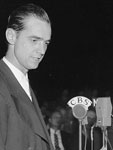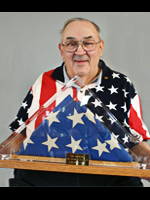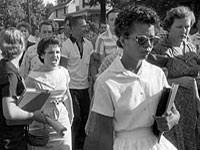This is the second in a series of film reviews reprinted from the Journal of American History. These reviews model ways of looking critically at popular films, documentaries, miniseries, and other history-based features. Look for one each month!
Jazz, the much-heralded 10-part PBS video series, is an American historical event in itself. The broadcast programs and their ancillary documents—a boxed set of 10 videocassettes, a book, a boxed five-CD set of music, a single CD personally selected by Burns, 22 jazz albums devoted to individual artists featured in the documentary, and more—is the most publicized and widely promoted presentation this music has received in its hundred-year history. The magnitude, scope, and all-embracing exploitation of musical, visual, and verbal elements might favorably be compared to Richard Wagner's vision of a Gesamtkunstwerk that, for him, resulted in a four-opera Ring Cycle, a theater specially built for the production at Bayreuth, disciples, detractors, enormous expense, and long-lasting consequences. Although we await the consequences, and regardless of criticism pro and con, Ken Burns's Jazz is a significant undertaking of great magnitude and serious purpose that will be remembered as an influential advocate for America's native art music, jazz.
The series should be considered from at least four points of view, for it succeeds in one, is less successful in two, and fails in the fourth.
The series should be considered from at least four points of view, for it succeeds in one, is less successful in two, and fails in the fourth. As an example of the documentary filmmaker's art, the craftsmanship is superb, and the series earns high marks. As a social history of jazz in the 20th century, the narrative is interesting and sometimes compelling, but the story is incomplete and exclusive. As a musical history of jazz, it fails miserably. And, finally, as the third large episode in the Ken Burns trilogy on race relations in America—The Civil War (1990), Baseball (1994), and Jazz—the three together and individually present a dramatic personal view of black and white tensions in America viewed from different vantage points and experienced in widely contrasting locales, environments, and time frames. The trilogy stands as a landmark historical presentation of one man's view of America's struggle for racial equality, and Burns has crafted his presentation so that it might be palatable and understandable to a worldwide lay audience. Of the three, Jazz has stirred the most interest throughout the world and the most diverse and fervid critical and popular reaction. Even before the series completed its public debut, an event stretching out over four weeks of prime-time television, the film impacted the art form itself, stirred artists, critics, and laymen into serious contemplative activity, stimulated the sales of jazz books, records, and concerts, and brought an unprecedented awareness of jazz and its heroes to a mushrooming audience.
After Nick LaRocca's claim that jazz was invented by the white musicians of New Orleans, the ever-ebullient Wynton Marsalis's stunned silence and loss for words is drama at its best.
As an example of the filmmaker's art, Jazz is stunning. Miles of footage and thousands of photographs and recordings demonstrating jazz performances, musical venues, and contemporary events and places have been recovered and discovered, cleaned up, selected, and sequenced to fit seamlessly in a tight narrative. Some of the images have not been published before, and all have been meticulously polished with the latest technical wizardry. Even long-familiar movie excerpts are presented better here than elsewhere. They are sharper, brighter, and fitted with a high-quality music track. The experts who appear as talking heads, most notably Wynton Marsalis, Stanley Crouch, Albert Murray, and Gary Giddens, are convincing and articulate individuals, and their insertion in the overall narrative is never superfluous or gratuitous. After Nick LaRocca's claim that jazz was invented by the white musicians of New Orleans, the ever-ebullient Wynton Marsalis's stunned silence and loss for words is drama at its best. Burns's camera captures every subtle inflection of eye movement, smile, shock, and grimace. Further, some of the interviews of living jazz musicians are truly poignant. When tears well up in the eyes of Dave Brubeck as he relates an incident in which his father showed him a cattle brand burned on the chest of a black neighbor, there is no escaping the gripping pathos of the moment. These videocassettes are of such high quality in both dramatic content and technical virtuosity that they will be used in schools for many years to help explain and promote this music.
As a social history of jazz in the 20th century, the film documentary is good but flawed. Its coverage of selected musicians, selected locales, and a 60-year time frame, 1900 to 1960, is excellent. Better to follow the lives and work of some great figures in depth than to create a superficial, all-inclusive list of players and tunes that everyone will forget. We can all quibble about whether it was better to spend more time on Coleman Hawkins but little or none on Art Tatum, Bix Beiderbecke, Bill Evans, or Benny Carter, but Burns's method of making a selection of key figures and dealing with each expansively keeps the series from being, as one critic aptly put it, balanced into blandness.
In taking the Great Man approach to history, Burns has adopted a 19th-century system of viewing events rather than a late-20th-century methodology for explaining our past.
He should not have pretended to deal with the last 40 years of the century, for episode 10 is totally inadequate and poorly done. Also, historians should be reminded that, in taking the Great Man approach to history, Burns has adopted a 19th-century system of viewing events rather than a late-20th-century methodology for explaining our past. Further, he accepts the medieval premise of speculum musicae, music as the mirror of reality. He states over and over that jazz reflects, at every stage of its development, the social, cultural, and political circumstances that surround it. This premise would be impossible to defend critically. There are times when this is true, and there are times when jazz is blissfully unaware of its surroundings. He gives, as one example, Louis Armstrong's "West End Blues" as "a reflection of the country in the moments before the Great Depression." I cannot see how he can support this statement. What is it reflecting? The African Americans in Harlem, the Wall Street entrepreneurs, or the white middle-class farmers in Kansas and Iowa? This is bull-session history. Gunther Schuller says in Early Jazz (1968).
Louis's "West End Blues" . . . startles us with the powerful thrust and punch of its first four notes. We are immediately aware of their terrific swing, despite the fact that these four notes occur on the beat . . . The four notes should be heard by all people who do not understand the difference between jazz and other music.
I understand what Schuller means and can check his words against the music itself. Also, in a different time frame, one can build a case for "Free Jazz" as antiestablishment music of the 1960s and view Max Roach's Freedom Now suite as an overt political statement, but the filmmaker's interest peaks out long before his cursory and superficial presentation of Ornette Coleman, Charles Mingus, John Coltrane, and their followers.
Jazz, the series, presents a tale of black musicians striving for equality, artistic recognition, and some of the regular entitlements of white, middle-class Americans, such as financial security, health care, freedom to travel, and so on, in a bigoted and essentially racist society. In doing so, Burns and his advisers ignore Latino contributions and circumstances, minimize the quality and magnitude of white contributors, and are seemingly unaware of jazz in Europe and Asia. Most important, in focusing on the first six decades of the century, they ignore the fact that American society has changed dramatically since 1960, and jazz was a part of that change. Black Is Beautiful, Black Power, the Nation of Islam, and the martyrdom of Dr. Martin Luther King Jr. (and the jazz stemming from these realities) all take place after the real end of his story. Episode 10, 1960 to the present, is clearly the weakest link in the series.
Musically, and as a musical history of jazz, the series is just short of a disaster. Tragically, laymen will never know the difference. In nearly every instance, even when a work is touted as a masterpiece, it is treated as elevator and restaurant music, something to be talked over and relegated to some level of subliminal perception. The height of disrespect and lack of awareness occurs when the narrator cites a performance as a defining work of art and then the director allows the sound engineer to change the music to fit the demands of the script.
The height of disrespect and lack of awareness occurs when the narrator cites a performance as a defining work of art and then the director allows the sound engineer to change the music to fit the demands of the script.
This happens many times throughout the series, often enough to convince this reviewer that, regardless of what the narrator says about the intrinsic value of the music, it rates no better treatment than timely background music for a movie. Charlie Parker's "KoKo" is a perfect example. "KoKo" is not movie music to be altered by deleting a few seconds here and adding a few seconds there, but Burns allows this to happen with the seamless virtuosity of digital technology. It is unthinkable that any literate spokesman for the arts would change 50 measures of Ludwig van Beethoven's Opus 127 string quartet immediately after declaring it to be a masterpiece of the genius's late period. Can anyone imagine Leonardo da Vinci's Last Supper being moved to a larger hall and having three disciples on the left copied and inserted into the frame on the right to fill the available space, making what might then be called Leonardo's Jesus and the Fifteen Disciples? Burns effects exactly this kind of sleight-of-hand with "KoKo" and other masterpieces by other great artists as well. Near the end of episode 7, after a showing of the dramatic atom bomb explosion on Hiroshima and after a few introductory words from the jazz altoist Jackie McLean, the narrator says.
On November 26th, 1945, 11 weeks after the surrender of Japan, Charlie Parker finally made his first recording under his own name for the independent label, Savoy Records. . . . Four sides were cut that day: "Billie's Bounce," "Thriving from a Riff," "Now's the Time," and a new tune, built on the chord changes of "Cherokee," called "KoKo."
The music begins, and, toward the end of the piece's musical introduction, the narrator adds his encomium: "'KoKo' is one of the most extraordinary recordings in jazz history. There is no doubt about it." "KoKo," by Charlie Parker, is a masterpiece of jazz art that lasts 2 minutes and 51 seconds beginning to end. There are no wasted notes, the phrases fall one after another in logical sequence, in a breathless drive toward a musical goal that can only be described as brilliant. The "KoKo" Ken Burns offers his listeners lasts approximately 4 minutes and 10 seconds, a hodgepodge of snippets glued together by digital splicing. It becomes a destroyed masterwork stretched for the convenience of a narration and for a closing quotation from Ralph Ellison, in which a reader states the episode's theme: "Usually, music gives resonance to memory. But not the music then in the making. Its rhythms were out of stride and seemingly arbitrary, its drummers frozenfaced introverts dedicated to chaos." Bebop was not dedicated to chaos! Ken Burns's recreation of "KoKo" is chaotic, for it destroys the symmetry, the syntax, and the grammar of a jazz classic. Ken Burns is no jazz musician, and I suspect he is not much of a musician at all. What he has fed us in four weeks of listening is a fascinating personal vision of race in America during the first six decades of the 20th century. Jazz, to him, is background music for his tale.
Strangely, that vitriolic critique is not the real bottom line of this review. This morning I ate breakfast in a blue-collar café and heard Bird and Diz playing "Salt Peanuts" on the piped-in local radio station. I have not heard real jazz on a pop music station since the 1950s, and I have Ken Burns to thank for that.




